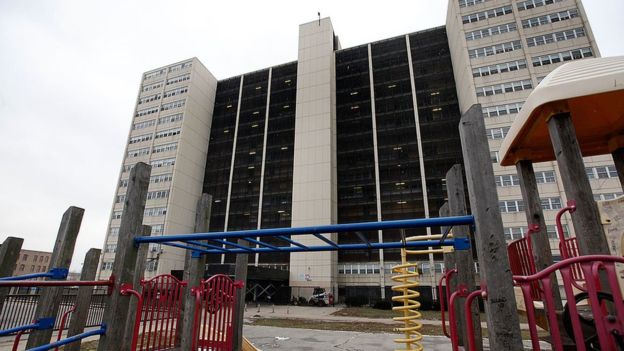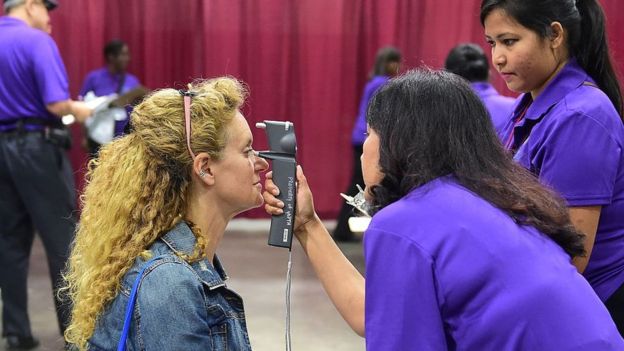What’s killing white middle-aged American women?

The rich world has got used to health and longevity getting better, and death rates falling for everyone.
But over the past few years, data has been accumulating which suggests that this trend has stopped for poorly-educated, white Americans.
And for one group in particular — middle-aged women — death rates are going up.
Four experts talk to the BBC World Service Inquiry programme to try and explain why.
Jennifer Karas Montez: An unexpected reversal
Jennifer Karas Montez is assistant professor of sociology at Syracuse University. Her award-winning research was among the first to flag up rising death rates among American women.
"A study came out in 2008 which was our first sign that something was amiss. It found that these mortality trends were actually going in the wrong direction for some education groups. We were really perplexed and not quite sure what to do with these results.
"They're highly significant. Between 1990 and 2010, life expectancy of low-educated white women declined by 1.2 years. That 1.2 years is about 13 years of progress washed away, so what seems to be minor changes in life expectancy signal really big problems going on underneath the surface.
"If we look at the trends in the US in an international context, it becomes even more stark. US women are at the bottom in terms of other high-income countries on these measures. So we've really fallen off; the trends have really diverged in an international context which tell us there's something unique going on in the US, especially for US women.
"One of the great things about the Case and Deaton study [published by two Princeton University academics in November 2015] is it finally elevated this issue that many of us have been concerned about for many years, since 2008 when it was first reported.
"This study finally had the breakthrough that we were all hoping for in terms of reaching a much broader audience and getting people to really believe that these problematic trends might in fact be real.
"Death is the ultimate indicator of how well we're doing, how well we're functioning as a society, how healthy we are mentally, physically, emotionally.
"A sustained increase in mortality is unprecedented. We're all scratching our heads thinking 'what do we do next, what could possibly be causing this?'"
Laudy Aron: Pieces of the puzzle
Laudy Aron is a senior fellow researching health and mortality with the Urban Institute, a research organisation based in Washington DC.
"There are a lot of different forces at play, and we need to be digging further. A number of recent studies are adding pieces to this bigger puzzle.
"Raj Chetty and colleagues came out with a very big study in the Journal of the American Medical Association in April looking at the association between income and life expectancy in the US between 2001 and 2014.
"They showed rich women outlive poor women by ten years. They also showed that these gaps between the rich and poor in terms of survival have been growing over time. So over the period that they looked at, the richest Americans gained about three years of life expectancy, while the poorest had no increase.
"The importance of place in terms of life expectancy and survival is one of the most interesting features of this study. It really shows that even at the same level of low income, you're better off in a more affluent, better-resourced community.
"That really points to the value of the other kinds of resources and opportunities that are available to you in these communities, in terms of the quality of the schools, the financial base, the tax base on which so many of our shared resources depend.
"It's one thing to raise your family in poverty, and your children in poverty, it's another thing to raise them when 40% of your neighbours are also living in poverty.
"My colleagues and I looked into the data and really started to dig into what's happening among white women, and we noted that we were seeing in particular a spike in women of both child-bearing and child-rearing years, and that the specific causes of death that seemed to be driving that were drug-related overdoses, cirrhosis of the liver, suicide, and similar types of causes.
"A lot of them are associated with health behaviours, but I want to caution that even a lot of these health behaviours and the mortality causes that underpin them occur in a context. So I think it's important that we understand the bigger environment in which these are occurring.
"It really is a constellation of factors having to do with social and economic wellbeing."
Dr Andrew Kolodny: Prescription killers
Dr Andrew Kolodny is a leading expert on opioid addiction and executive director and co-founder of Physicians for Responsible Opioid Prescribing. Opioids are painkillers which have a similar effect to heroin and are also derived from opium.
"I remember looking at some early federal reports involving opioid painkillers and overdose deaths, and they had increased so rapidly that when I was looking at the data, I was convinced someone had put a decimal point in the wrong place.
"The sharp increase was very real and what we would ultimately come to recognise is that we were at the beginning of a new and very severe epidemic.
"The reason the medical community began to prescribe opioids so aggressively is that we were responding in many ways to a brilliant marketing campaign launched by the maker of one opioid pain medicine, a drug called Oxycontin."
In 2007 Purdue Pharma pleaded guilty to misleading doctors and patients about the addictive properties of OxyContin and paid $600m (£415m) in fines. It also reformulated OxyContin to deter abuse.
"Rates of overdose deaths [from opioids generally] begin to soar: from 1999 to 2014, 250,000 Americans have died of an opioid overdose. Today there are more Americans dying of drug overdoses than dying from motor vehicle crashes,
"This is the worst drug addiction epidemic in US history. We have about 10 to 12 million Americans on opioids chronically, so many that drug companies can now make money selling medicines to treat the side effects from being on opioids chronically.
"We've seen a very sharp increase in prescription opioid overdoses in women. I think one of the reasons is that middle-aged women are more likely to receive treatment for a chronic pain problem from a doctor, [and] they're more likely to be prescribed prescription opioids.
"This epidemic is almost completely white. It's so white that it's fair to say that it's protective in some ways to be African-American or Latino.
"What I think may be happening is that if the patient is black, the doctor is more concerned about the possibility of the patient becoming addicted or of the patient selling their pills.
"Racial stereotyping is having a protective effect on non-white populations."
Jennifer Silva: Lost generations
Jennifer Silva is assistant professor of sociology at Bucknell University, and the author of Coming Up Short: Working-Class Adulthood in an Age of Uncertainty.
"I've been to central Pennsylvania, rural Ohio, Texas, Oregon and Minnesota, and in most of these places the jobs have left and families are trying to cope with what comes next.
"When you look at the grandparents' generation, you see very stable communities, stable marriages, often the grandfathers worked in the coal mines or on the railroads and had a very rich community life where people were embedded in their unions and their churches and their ethnic clubs.
"Some of the remaining good blue collar jobs — such as fire-fighter or police officer or joining the military — do seem to be pretty male-dominated jobs. For women, it is more difficult to see a job that would pay good wages or give you benefits, whether retirement or good health insurance, So women end up with the lower-paid service jobs.
"I have talked to many young adults in their 20s or early 30s who tell harrowing stories of family trauma, of watching their parents choose drugs or alcohol over them. A young woman named Ashley told me her mother would use drugs and then her stepfather would drive her to school every day with a Bloody Mary between his legs and smoking marijuana.
"People are trying to solve the crisis on their own. I see a lot of relying on the internet to try to treat, especially mental health problems. I had an older white woman who was suffering from self-diagnosed depression, but a few years later I learned she actually died of a brain tumour but she never went to a doctor because she couldn't afford it.
"[These people] are often not working, not in relationships, just not connected to any kind of social organisations. In this coal region there used to be a church on every corner and people would join together and socialise and exchange information, but now, most of those churches have closed down.
"We have a whole generation of people who are just in some ways wasted talent. There's a lot of suffering, a lot of desperation, fear, vulnerability, and hopelessness. They're not really sure how they can make a world better for their children and they feel very betrayed."
Политика конфиденциальности | Правила пользования сайтом










